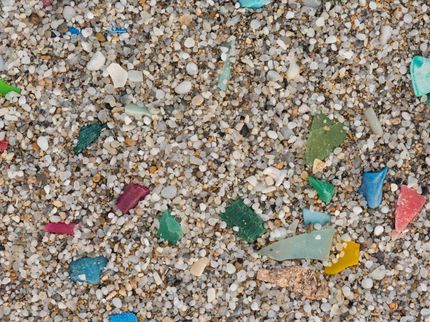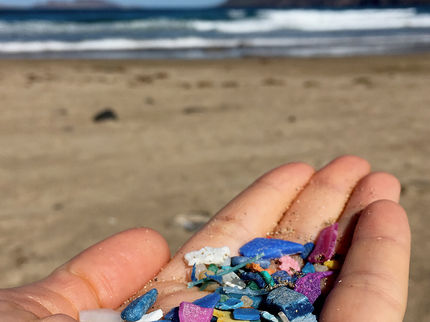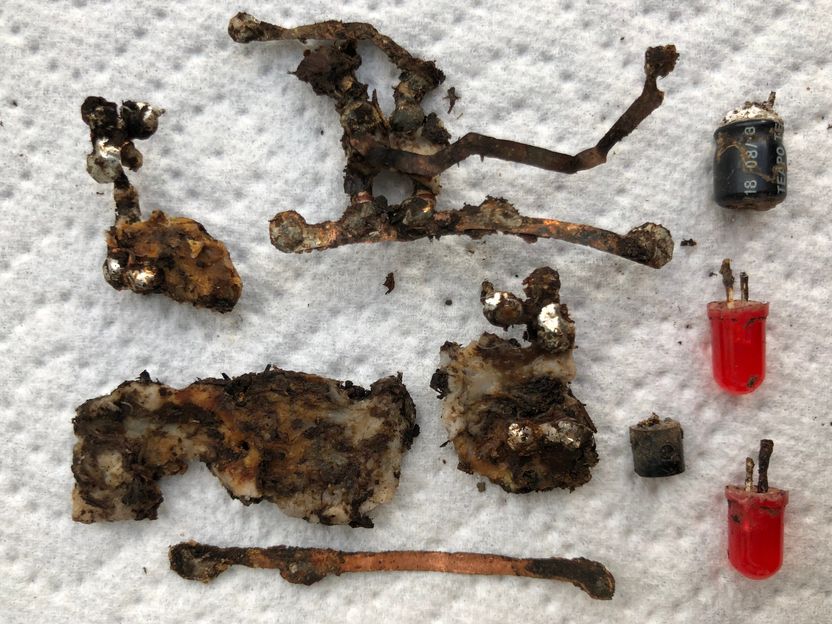Bye-bye microplastics: new plastic is recyclable and fully ocean-degradable
“With this new material, we have created a new family of plastics that are strong, stable, recyclable, can serve multiple functions, and importantly, do not generate microplastics”
Researchers led by Takuzo Aida at the RIKEN Center for Emergent Matter Science (CEMS) have developed a new durable plastic that won’t pollute our oceans. The new material is as strong as conventional plastics and biodegradable, but what makes it special is that it breaks down in seawater. The new plastic is therefore expected to help reduce harmful microplastic pollution that accumulates in oceans and soil and eventually enters the food chain. The experimental findings were published Nov 22 in Science.

Artistic rendering of the new plastic. Cross linked salt bridges visible in the plastic outside the seawater give it its structure and strength. In seawater (and in soil, not depicted), resalting destroys the bridges, prevending microplastic formation and allowing the plastic to become biodegradable.
RIKEN
Scientists have been trying to develop safe and sustainable materials that can replace traditional plastics, which are non-sustainable and harm the environment. While some recyclable and biodegradable plastics exist, one big problem remains. Current biodegradable plastics like PLA often find their way into the ocean where they cannot be degraded because they are water insoluble. As a result, microplastics—plastic bits smaller than 5 mm—are harming aquatic life and finding their way into the food chain, including our own bodies.
In their new study, Aida and his team focused on solving this problem with supramolecular plastics—polymers with structures held together by reversible interactions. The new plastics were made by combining two ionic monomers that form cross-linked salt bridges, which provide strength and flexibility. In the initial tests, one of the monomers was a common food additive called sodium hexametaphosphate and the other was any of several guanidinium ion-based monomers. Both monomers can be metabolized by bacteria, ensuring biodegradability once the plastic is dissolved into its components.
“While the reversable nature of the bonds in supramolecular plastics have been thought to make them weak and unstable,” says Aida, “our new materials are just the opposite.” In the new material, the salt bridges structure is irreversible unless exposed to electrolytes like those found in seawater. The key discovery was how to create these selectively irreversible cross links.
As with oil with water, after mixing the two monomers together in water, the researchers observed two separated liquids. One was thick and viscous and contained the important structural cross linked salt bridges, while the other was watery and contained salt ions. For example, when sodium hexametaphosphate and alkyl diguanidinium sulfate were used, sodium sulphate salt was expelled into the watery layer. The final plastic, alkyl SP₂, was made by drying what remained in the thick viscous liquid layer.
The “desalting” turned out to be the critical step; without it, the resulting dried material was a brittle crystal, unfit for use. Resalting the plastic by placing it in salt water caused the interactions to reverse and the plastic’s structure destabilized in a matter of hours. Thus, having created a strong and durable plastic that can still be dissolved under certain conditions, the researchers next tested the plastic’s quality.
The new plastics are non-toxic and non-flammable—meaning no CO2 emissions—and can be reshaped at temperatures above 120°C like other thermoplastics. By testing different types of guanidinium sulfates, the team was able to generate plastics that had varying hardnesses and tensile strengths, all comparable or better than conventional plastics. This means that the new type of plastic can be customized for need; hard scratch resistant plastics, rubber silicone-like plastics, strong weight-bearing plastics, or low tensile flexible plastics are all possible. The researchers also created ocean-degradable plastics using polysaccharides that form cross-linked salt bridges with guanidinium monomers. Plastics like these can be used in 3D printing as well as medical or health-related applications.
Lastly, the researchers investigated the new plastic’s recyclability and biodegradability. After dissolving the initial new plastic in salt water, they were able to recover 91% of the hexametaphosphate and 82% of the guanidinium as powders, indicating that recycling is easy and efficient. In soil, sheets of the new plastic degraded completely over the course of 10 days, supplying the soil with phosphorous and nitrogen similar to a fertilizer.
“With this new material, we have created a new family of plastics that are strong, stable, recyclable, can serve multiple functions, and importantly, do not generate microplastics,” says Aida.
































































